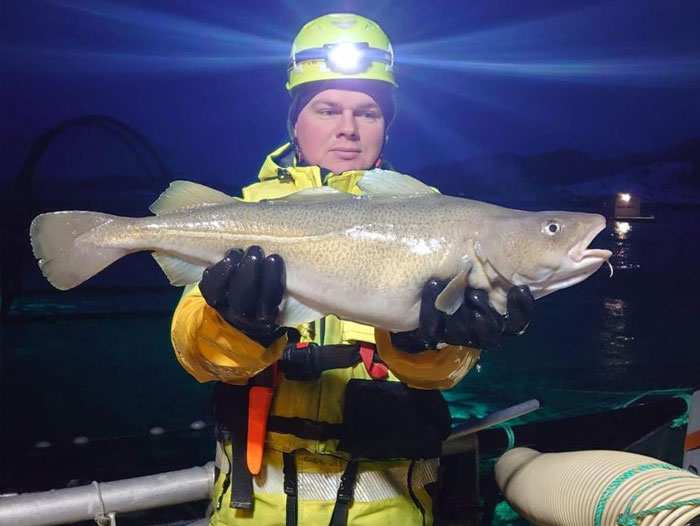Norcod Ends 2020 On High Note
February 25, 2021 | 4 min to read

Norwegian aquaculture venture in strong position after its first full year of operations and gearing up for its first sales of farmed cod this summer.
Highlights from the fourth quarter of 2020 include exceptional biological performance of the fish, getting a second production cycle underway with the transfer of a new batch of fry to growth facilities, equipment and feeding barges ordered in support of ongoing production, and management changes that put the company on the road to achieving new milestones.
Operating costs under budget
“We are in a very good position to continue our planned growth according to plan,” said CEO Christian Riber. “Plus, we succeeded in keeping operating costs under budget by NOK 12m for the entire year. Our team have done a fantastic job.”
Norcod has come a long way since start-up only 18 months ago. “We have worked incredibly hard during the establishment phase, applying for licences, securing sea sites and creating an entire value chain for farmed cod from broodstock to market-ready product,” says Riber.
Sales income from Q3 2021
He emphasizes that the company has not yet generated any profits because its first production cycle is still underway. The production cycle lasts around 18 months. “Obviously we haven’t made any money yet because we don’t yet have a finished product to sell. Sales income from our first production cycle will start when we start harvesting in Q3 this year, and from our second production cycle in 2022. But we are well on the way.”
Close monitoring of fish performance is core to Norcod’s daily operations, with technicians making frequent inspections of individual fish in order to map production trends. Calm behaviour and well-distributed biomass in the sea pens indicate good animal welfare, with high feed efficiency and low mortality. “Exceptional biological performance lowers both risk and costs,” says Riber.
Quality biomass
Norcod has access to sixth-generation cod fry that are bred for optimal health and yield. “For that we have to thank our joint-venture partner, Havlandet Norcod AS,” says Riber. “Our latest batch of fry was successfully transferred to growth facilities in the fourth quarter and they will begin the sea phase in June.”
Norcod opted only to buy new modern equipment from the outset, which has helped to keep operating costs down. “Our use of in-house expertise related to technical site work also reduced our need to purchase external services,” says Riber.
Sustainability focus
The company took delivery of a new hybrid-electric feed barge at the end of December for its Jamnungen site. It has a further two on order, as well as catamaran service vessel also equipped with batteries. “Reducing fuel consumption and emissions is a key part of our efforts to ensure sustainable production,” says Riber. “We are implementing waterborne feeding technology on the last two barges which will further reduce energy consumption. Our electrified service vessel will also cut noise during daily operations which is good not only for the fish but also our employees and the surrounding environment.”
Listing swells coffers
Financing activities during 2020 provided Norcod with both new equity and loans. Net cash flow from financing activities was NOK 420m in 2020 versus NOK 43m in 2019. The company had cash and cash equivalents of NOK 199m at the end of 2020 as against NOK 8m at the same time the previous year. Investment and financing activities generated positive cash flow of NOK 420.5m, up from NOK 378.9m in 2019. This was due to the company’s listing on the Oslo Stock Exchange’s Euronext Growth in October.
High demand
Norcod garnered very positive feedback from samples sent to the US and various countries in Europe from its first trial harvest in December. “We will conduct another and final out-take of cod in the second quarter of this year to further promote our product before our first harvest begins in the summer. We aim to produce 6,000 metric tons of fresh farmed cod in this first cycle, and a harvest volume of 10,000 metric tons in 2022,” says Riber. He adds that market demand is high, with some samples fetching a strong NOK 65 per kilo and an average of NOK 56 per kilo.
Norcod is following the Norwegian authorities’ guidelines regarding Covid-19, and adapting to the situation as necessary. “We are taking care to avoid any operational disruption and are in close dialogue with suppliers to keep upcoming equipment deliveries of equipment on track. Fortunately, we have not experienced any direct adverse consequences due to good planning,” says Riber.
Bright outlook
“Right now, we are exactly where we want to be and following our carefully laid plan. Our ambition is to provide healthy protein through responsible farming of cod on an industrial scale, with sales contracts for year-round supply. We have a watertight business model, customers are eagerly awaiting our product and we look forward to becoming profitable when sales begin,” Riber says.
He took over as CEO from Hilde Storhaug during the fourth quarter. Storhaug continues as CSO in charge of Norcod’s sustainability activities. Aquaculture industry luminary Marit Solberg accepted the invitation to become Chair of the Board. “We have a great product, massive combined industry expertise and the backing of seasoned industry investors. 2021 should be a great year,” Riber concludes.
About Norcod
Norcod AS’ core business is commercial sea farming of cod but through ownership and partnerships is involved in the entire value chain. Norcod’s fish farms are located in Mid-Norway with ideal cold-water habitat conditions for cod. The company is contributing to blue ocean value creation with minimal impact on the environment while supporting local communities. Norcod is listed on the Oslo Stock Exchange’s Merkur Market.
